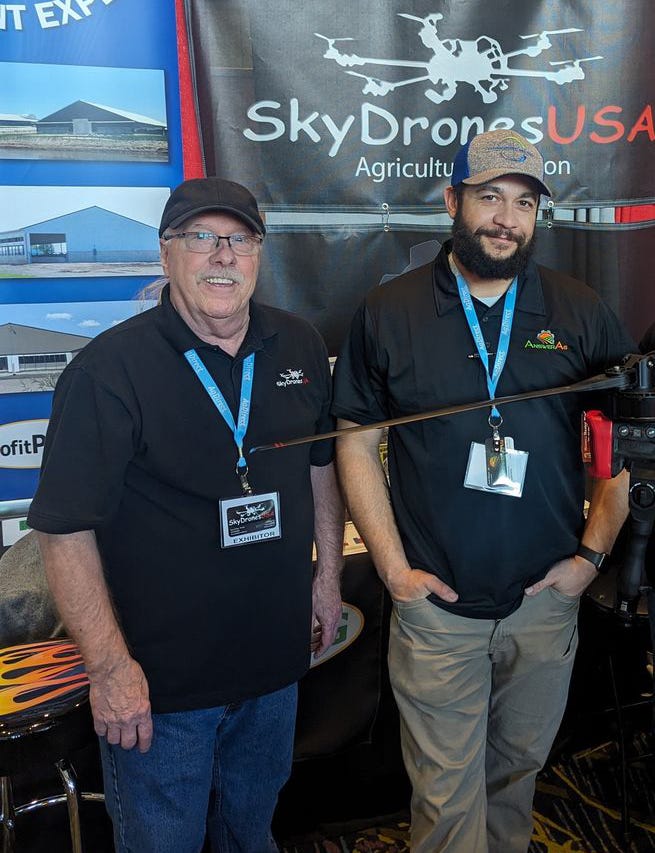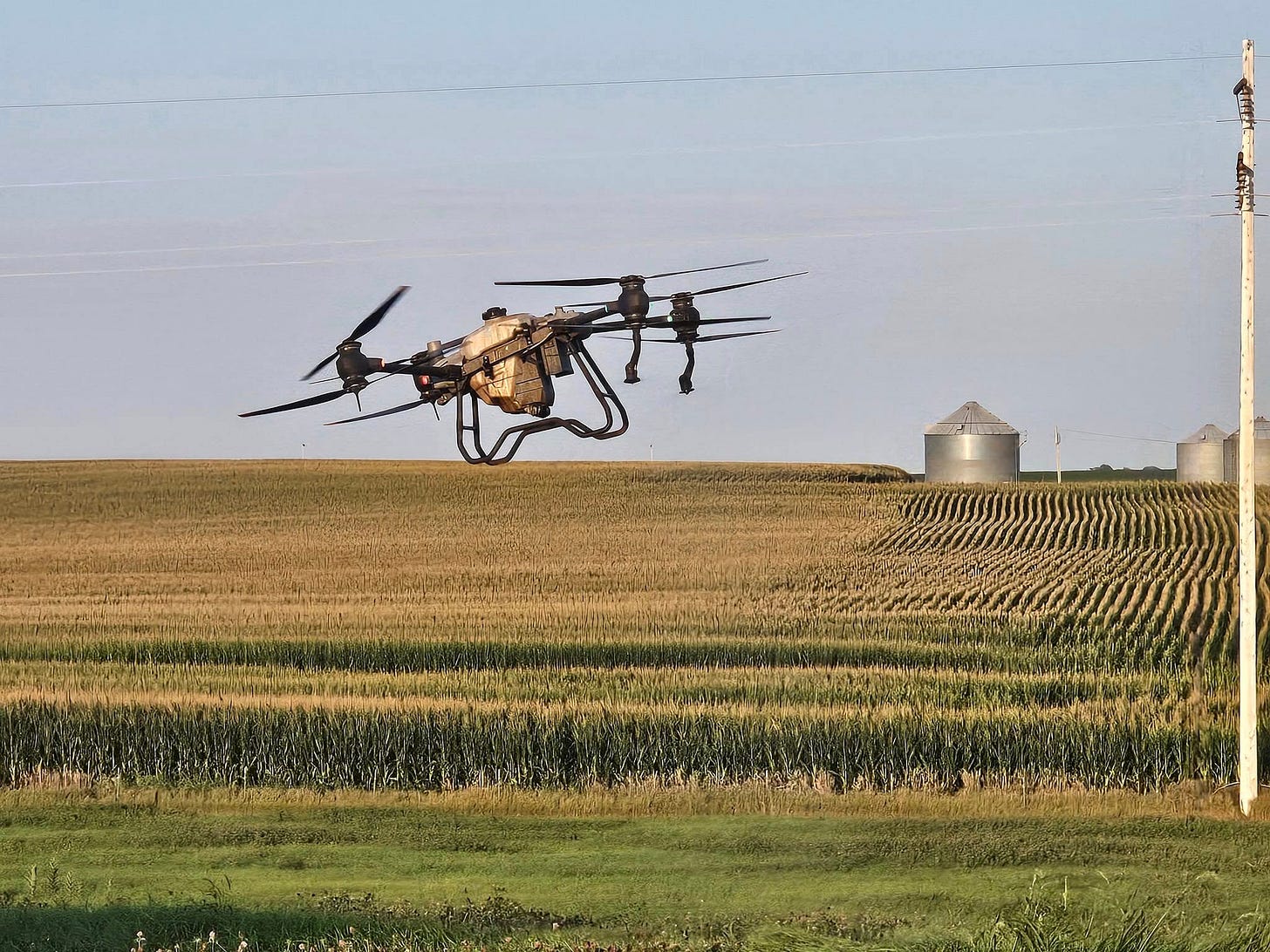Are Drones a Key to Eco-Friendly Farming?
As a farmer, it's exciting to see how drones can pay in more ways than one
On a warm, late-summer evening last August, an “eye in the sky” was sweeping over our property, and it drew a small crowd of neighbors and family members. A drone was hard at work, spot-spraying our pasture northwest of Lake City to help control weeds. What we were all watching from this small drone in Calhoun County has big implications for the future of farming in Iowa and beyond.
To learn more, I reached out to one of the leaders in this ag tech field—my friend, Duane Davis. Duane is the founder of SkyDronesUSA, a Gowrie-based distributor of drones and drone accessories. Drones can fill a lot of niches, he notes.
Looking for a way to save on crop inputs? Want to apply foliar fertilizers? Seeking greater efficiency and higher yield potential. “Drones check all these boxes,” Duane told me.
While drones aren’t new, rapid advances in technology have made them one of the hottest technologies transforming agriculture today. “Farmers in the 35- to 50-year age range are especially interested in drones,” says Duane, who attended numerous ag shows across Iowa, Minnesota, Kansas and other states this past winter. “We were just swamped at the trade shows.”
A lot of these farmers Duane visited with are interested in reducing the amount of chemicals they use. They also want more control over timely applications, whether they’re spraying crop-protection products or applying foliar plant nutrition products.
“Customers are reporting that drones are paying for themselves in just one growing season,” says Duane, who noted that the entry price point for most of these drones ranges from $35,000 to $45,000.
This fast return on investment (ROI) is possible due to timely applications. “If farmers hire custom application from an airplane, helicopter or a ground rig, the applicator may not be able to get the job done within the critical time frame,” Duane says. “Drones give you a lot more flexibility.”
If a late-day rainstorm prevents a ground rig from getting into the field for a few days, for example, a drone can fly that same field much sooner. Drone pilots now can legally fly their drones at night to apply fertilizers and crop-protection products. (This is a plus, since there’s usually little or no wind at night, Duane says.)
New regulations from the Federal Aviation Administration (FAA) also permit swarming, where multiple drones operate at the same time and cover more acres quickly. “In addition, you can now fly drones out of the line of sight,” says Duane, who noted that GPS and RTK satellite technologies guide the drones.

Researchers put drones to the test
SkyDronesUSA has grown as the technology has evolved. “When we started in this business 14 years ago, we were strapping GoPro cameras on the belly of the drone,” Duane says. “Then it would take days to ‘stitch’ all the images together in software to make the data useful.”
The capabilities of today’s high-tech drones have gone far beyond that. “The data gathered by the drone becomes a valuable record to help farmers track the changes they make and fine-tune their farm management year after year,” Duane notes.
SkyDronesUSA, a veteran-owned, family-operated business with more than 40 years of consumer electronics experience, specializes in unmanned aerial vehicles (UAVs) for agricultural use. AnswerAg, a partner of SkyDronesUSA, helps optimize applications (from cover-crop seeding to foliar feeding and other inputs) and multi-spectral mapping, which helps farmers and agronomists spot areas of nutrient deficiencies, weed pressure and disease challenges.

While this all sounds great, I asked Duane what concerns farmers have when they ask him about drone technology.
“The main skepticism we hear is, ‘Can a drone really do the job?’”
The research says yes. In late 2024, Iowa State University (ISU) shared results from a field demonstration of weed mapping and precision weed control in soybeans. Researchers used Sentera’s Aerial WeedScout (AWS) drone technology to apply 70 gallons of tank mix over 8.7 acres of soybeans, post-emergence. A broadcast application of 15 gallons per acre over the same area would have resulted in 130.5 gallons of tank mix applied.
Product savings were near 50% and resulted in an economic savings of $13.42 per acre from reduced chemical use, notes Doug Houser, a digital agriculture Extension specialist with ISU.
Researchers also tracked weed control success by repeated weed counts across sub-sections of the field. The initial weed count yielded 118 weeds in the area of interest, with a second counting 17 days after executing the AWS prescription. This revealed herbicide injury on 117 (>99%) weeds. Of the 118 weeds, 111 (94%) were dead.
At harvest, the AWS treatment area had a final yield within 1.5 bushels per acre of the broadcast control, with no significant difference between treatments, according to ISU.
Beck’s Hybrids is also studying drones. Starting in 2023, the seed company began incorporating drone technology into some of its Practical Farm Research (PFR)® fungicide trials for corn and soybeans. These trials were conducted at multiple PFR sites across Beck’s marketing area, with on-farm cooperators in Illinois and Missouri.
The 2023 data showed that drones outperformed ground machines by 3.4 bushels per acre in corn and 1.8 bushels per acre in soybeans. The Beck’s Hybrids team continued this research in 2024.
For the ground rig-versus-drone trials in corn, the drone yielded statistically the same as the ground machine, with an 8.6 bushel-per-acre gain over the untreated control. When looking at the two-year data, the drone was significantly ahead, with a positive ROI of $14.75 per acre, compared to the untreated control.
In the 2024 soybean trials, neither application was profitable. However, the drone yielded 0.5 bushel per acre better than the ground machine. Looking at the two years of data, the drone has the highest ROI of $13.78 per acre, while the ROI for the ground machine was -$1.23 per acre.
“Regarding the key question, ‘Can drones effectively be used for fungicide applications?’ the short answer is yes, but we need at least one more year of trials to confirm this,” noted Clayton Stufflebeam, a PFR agronomist with Beck’s Hybrids.
Drones work from row-crop fields to pastures
Farmers and ranchers across the nation are using drones for a variety of applications, from row crops to pasture management. “Pasture ground can be pretty rough, but drones can handle it,” Duane says. “In Texas, ranchers are using drones to control cactus, while ranchers in Oklahoma are using drones to control mesquite.”
With row-crop production, drones help control soil compaction, plus they protect the crop. “The national average is 7% damage when ground-rig sprayers run over crops,” Davis said. “Farmers tell me it’s way worse than 7%, though.”
In dry conditions, the big tires on ground spray rigs kick up a lot of dust. “When the liquid being applied mixes with that dust, the heavy particles fall to the ground, which doesn’t help the plants,” says Duane, who noted that plugged spray nozzles can also create challenges. “You don’t have these issues with drones.”
American-made drones coming soon
Since the vast majority of drones used in agriculture are manufactured in China, the Trump administration’s tariffs are having a big impact on that market. SkyDronesUSA works with a variety of suppliers, including DMR, a company based in Detroit, Michigan.
While DMR’s drones are currently manufactured in Thailand, DMR plans to begin manufacturing drone flight controllers (computer chips) in Detroit by late 2025. The company is preparing to manufacture drones in Detroit in 2026.
Duane told me he’s excited about new hybrid technology from DMR, which will allow for longer flight times. The 70-liter model should be available by July 2025, while the 100-liter model is slated for 2026. “Along with a much larger payload, these drones will be able to fly 40 minutes to an hour at a time,” he adds.
That’s a huge improvement from current drone technology. “Today’s drones have tanks that average 50 to 70 liters, and you can only get about 11 or 12 minutes of flying time before you need to recharge,” Duane says.
Modern advancements in drone technology are the equivalent of going from a horse and buggy to a car, Duane emphasizes. “This is the future of farming.”
Have you explored the variety of writers in the Iowa Writers’ Collaborative? They are from around the state and offer an intriguing variety of perspectives, focused on Iowa and the Midwest. Please consider a paid subscription. It helps keep us going, and it keeps you in the know. Thank you!




